For those of you under 80, the year 1955 and the Kansas City A’s may seem like ancient history. Speaking as a person over 80, I understand that. But I can’t fully let go.
The year 1955 infiltrated my DNA, not just with baseball, but with music and cars. I know the words to the golden oldie songs. I knew the differences in the makes and models of cars. I can’t do those things with today’s music and cars. So, yes, it’s personal. And I’m betting on your liking the golden oldie setlist in Lonnie’s Jukebox.
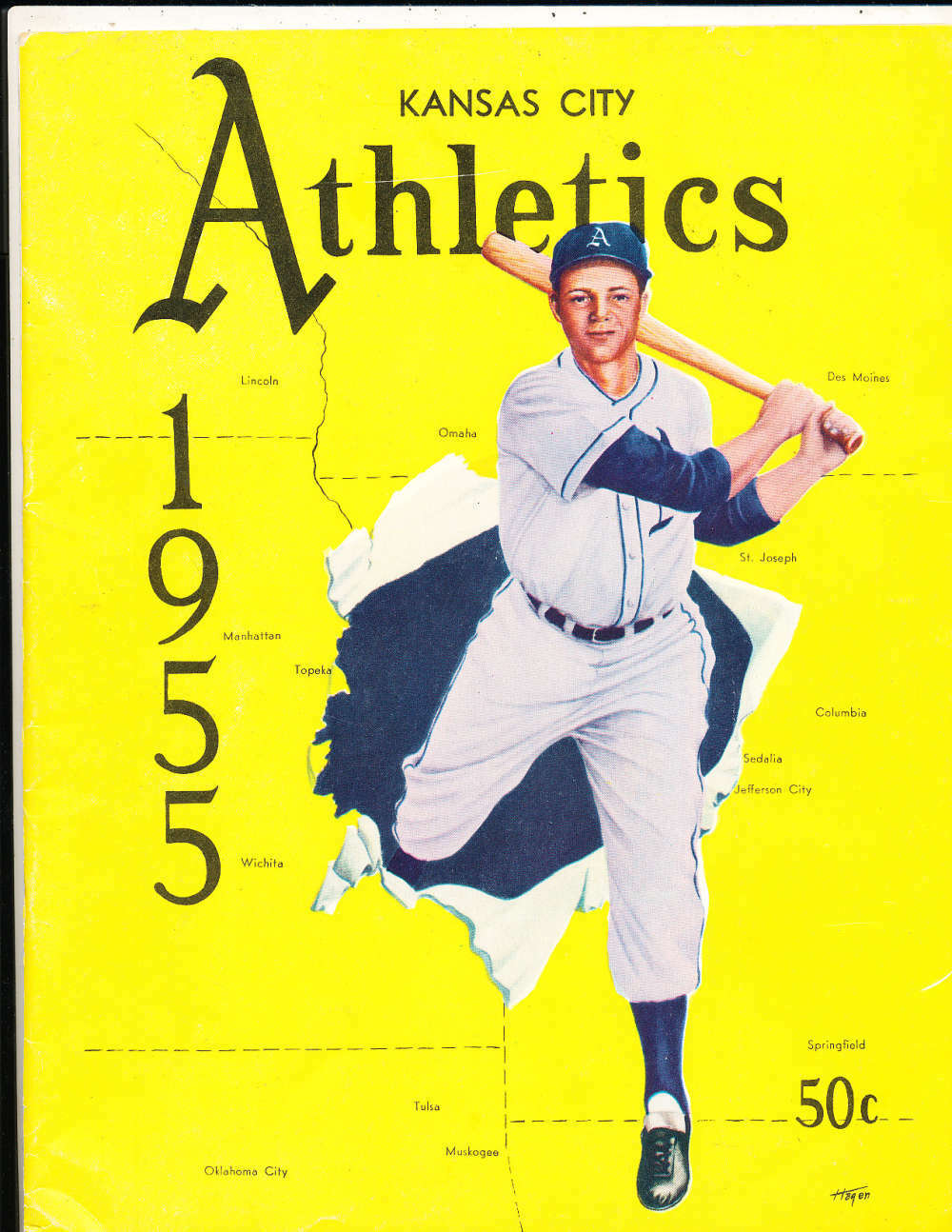
Today’s post was prompted by some tweets that took me back to 1955 – to the Kansas City A’s – plus a tip from Crosby Kemper about those A’s. I took that info and followed it down some rabbit holes via Google.
Bobby Shantz and Elmer Valo: The Philadelphia A’s relocated to Kansas City in 1955. It was wonderful for a baseball nut like me. I was in the 8th grade and went to opening day on April 12 with my friend Jay DeSimone. Former President Harry Truman threw out the ceremonial first pitch. Jay and I went to about 20 games that first season.
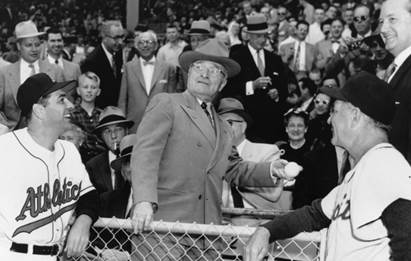
Bobby Shantz and Elmer Valo were two of the players who moved with the team to Kansas City, and although almost seven decades have gone by, each player has recently received shoutouts on “TwiXter.”
Shantz, a 5’6” pitcher, was well known when he arrived in Kansas City. He was a good starter on a bad A’s team for several years. In 1952, he went 24-7 and was named MVP of the American League. He pitched in Kansas City for two years and then played for six other teams in finishing off a 16-year MLB career. He was a three-time all-star, got MVP votes in three seasons and won eight gold gloves.
The reason Shantz was recently in the news was a video tweet of him signing his 1952 baseball card for a young collector. When you watch the video (click here), remember that you are seeing a 98-year-old who is still signing autographs. He is the oldest living MVP and the sole survivor of those who played for the Philadelphia A’s.

Last month, I was reminded of Elmer Valo by an article tweeted by the Royals Review blog. It was a good read about Valo’s “fascinating career” as an excellent hitter with a penchant for crashing into walls to make catches in the outfield. I had forgotten just how good he had been in that first Kansas City season of 1955. He played in 112 games, slashing .364/.460/.484 with and OPS+ of 155. He picked up some down-ballot MVP votes but did not have enough at bats to qualify for the batting title (won by Al Kaline with an average of .340).
I knew that sabermetrics guru Bill James was an Elmer Valo fan and dug up a series of tweets from 2020.
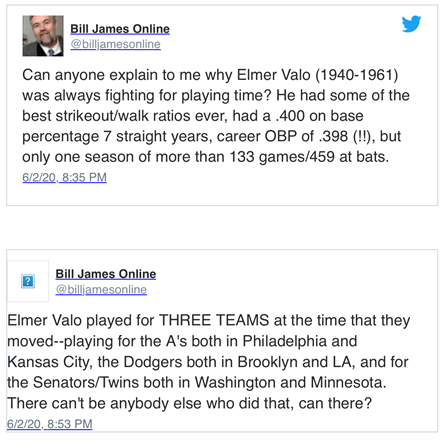
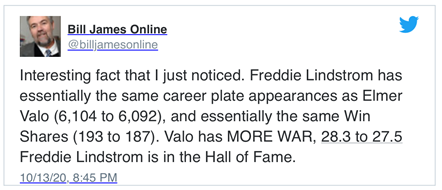
What a great piece of trivia in that second tweet. Played in both cities for three relocated teams.
In the pre-union days of 1955, individual players made their own deals for baseball cards. Some the 1955 A’s signed with Bowman (Shantz below), and others signed with Topps (Valo below). So, anyone collecting a full team set needed to acquire cards issued by both companies.
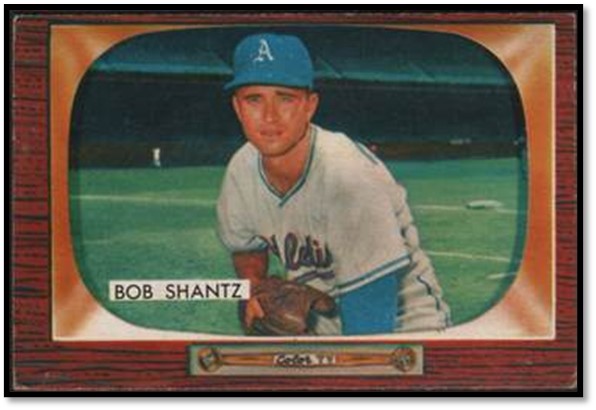
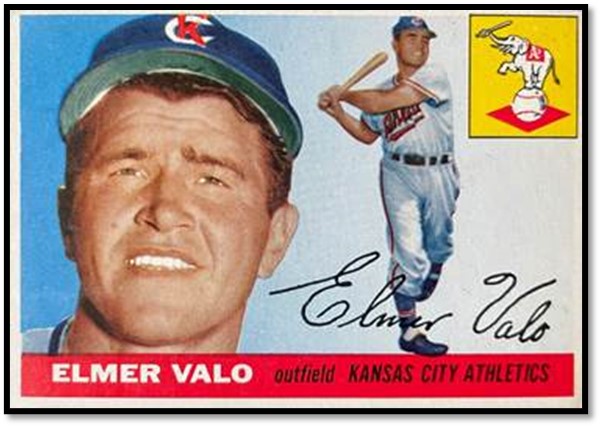
Some other KC A’s players in 1955: Vic Power, Hector Lopez, Jim Finigan, Joe DeMaestri, Joe Astroth, Enos Slaughter, Harry “Suitcase” Simpson, Art Ditmar, Alex Kellner and Gus Zernial. For a fun nostalgia break, check out the superb Kansas City A’s memorabilia collection at Chappell’s Restaurant & Sports Museum in North Kansas City (website here). The collection was assembled by Jim Chappell who tells great stories about the players and maverick owner Charlie Finley who purchased the A’s in 1960.
Kansas City A’s/Seattle Pilots: Crosby Kemper shared with Hot Stove his favorite Kansas City A’s trivia (he believes he heard it from Bill James):
The A’s are the only franchise that played in a city for more than one season and never had a winning season in that city. The A’s were in KC from 1955 to 1967 (13 seasons), and their best year was 1966 (74-86).
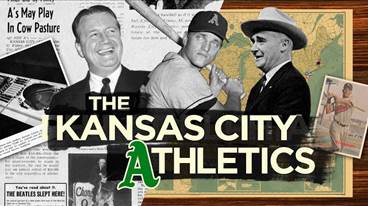
Why the “more than one season” exception? In 1969, the American League added two teams, the Kansas City Royals and the Seattle Pilots. The Pilots finished the 1969 season 64-98, went into bankruptcy and were bought by Bud Selig just days before the 1970 regular season started. Selig immediately moved the team to Milwaukee, meaning the Pilots hold the MLB record for shortest stay in a city (one season).
Seattle Pilots/Milwaukee Brewers: When Bud Selig bought the Pilots just before opening day, the player photos for Topps baseball cards had already been printed for the season. So, the 1970 cards for the Milwaukee Brewers players show them in their Seattle uniforms along with a big PILOTS to leave no doubt. Below, the 1970 Topps card for the Milwaukee Brewers’ John O’Donoghue.
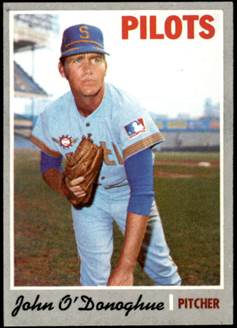
Trivia on Trivia: O’Donoghue is a Kansas City native who played Ban Johnson League ball in 1956 and 1957 for Moody Motors, a Ford dealer in my hometown of Independence. In 1958, in the spring semester of my junior year at Van Horn High School, I bought my first car at Moody, a used 1954 Ford.
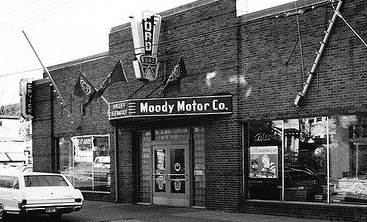
O’Donoghue played college ball at Missouri University. He was drafted by the Kansas City A’s in 1959 and moved up to the majors in 1963. After playing three years for the A’s, he moved on to Cleveland (1966 and 1967) and then Baltimore (1968).
In May of 1969, O’Donoghue was traded to the Seattle Pilots who were playing their inaugural (and only) season. The timing was perfect for making it a memorable year. One of his teammates in Seattle was Jim Bouton who used that year as the basis for his 1970 best-seller Ball Four. Bouton’s controversial book revealed the everyday off-the-field life of players. Carousing, drinking, pill-popping, etc. The good sides too: sensitivity, vulnerability, curiosity. It showed the players were human, not a bunch of vanilla heroes. One of the often-quoted players in the book was John O’Donoghue.
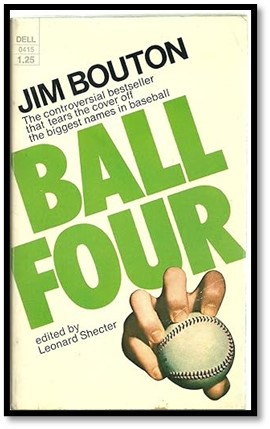
O’Donoghue moved with the team to Milwaukee in 1970 (the baseball card above). He was traded that summer to the Expos where he finished his 9-year MLB career in 1971.
Spring Training: Spring training is underway, and the Royals played their first Cactus League game last Friday against the World Champion Texas Rangers. The Royals share their spring training facilities with the Rangers, and so the stadium has been the home of two World Series winners in recent history (Royals in 2015). The distance from Surprise, Arizona, to the hometowns…

The Royals broadcast schedule for spring training is here.
Lonnie’s Jukebox – Cars and Rock ‘n’ Roll in 1955: While I was enjoying the first season of American League baseball in Kansas City, two other topics were competing for space in my teenage brain – cars and music (girls and school also competed for space but that’s beyond the scope of today’s post).
Ford and Chevrolet, the best-selling cars at the time, had made substantial styling changes in their 1955 models. This was also the first year for Chevy to have a V-8, and it would prove to be a base for very popular racing engines. I was just turning 14 that summer but already dreaming of getting behind the wheel of a cool car. Maybe even someday one of these gems.
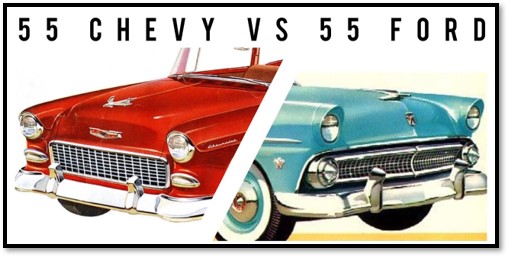
On the music side, the emerging genre of rock ‘n’ roll was taking the teenage world by storm. I started buying 45-rpm records. In March of 1955, “Rock Around the Clock” by Bill Haley and the Comets hit the charts. In July came Fats Domino with “Ain’t That a Shame.” In August, we were in awe of a song that combined cars with Chuck Berry’s classic guitar riffs and backbeat…
“Maybellene” by Chuck Berry (1955). The lyrics came partially from Berry’s high school memories of trying to get girls to ride in his 1934 V-8 Ford. In the song, he is driving his V-8 Ford and begins chasing a Cadillac Coupe de Ville where his girlfriend is riding with another man. “Maybellene, why can’t you be true.”
This was hardly the first song to combine cars, speed and sexuality. There were plenty of earlier country, folk, and rhythm and blues songs that embraced cars, romance and the open road. One R&B hit from 1951 is considered by many to be the first true rock ‘n’ roll song before the genre became popular. It was recorded at Sam Phillips’ Sun Studios in Memphis…
“Rocket 88” by Jackie Brenston and the Delta Cats (1951). The Delta Cats existed in name only. The backing band for Brenston’s singing was Ike Turner and his Kings of Rhythm. The Oldsmobile 88 with a Rocket V-8 engine first came out in 1949 and is often called the first muscle car.
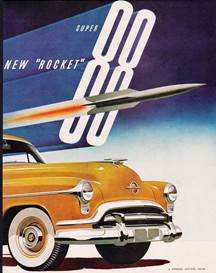
In 1955, to curb illegal street racing, Kansas City businesses and city officials decided to construct a dragstrip. It opened in July near Chouteau Trafficway and Front Street and became a model for other cities with similar issues. There were organized trophy races on weekends, and the strip was available at all other times (day and night) for anyone. Two years after it opened, some of my Van Horn classmates became active in working the tech/inspection line for organized races at the dragstrip.
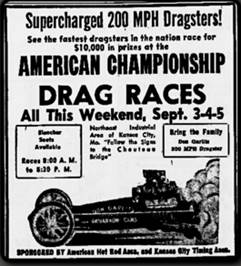
“Speedo” by the Cadillacs (1955). Not about cars but look at the name of the group. This record hit the charts on December 10, 1955. To put this in perspective, nine days earlier, Rosa Parks refused to give up her seat on the bus.
“Drive In Show” by Eddie Cochran (1957). An extra reason to have a car was to listen to rock ‘n’ roll on the radio – not always welcome music at home. Another good reason is in this song by Eddie Cochran. “When we’re parkin’ in the drive-in show/We’ll be sittin’ in the moonlight row.”
I turned 16 on August 9, 1957, and got my driver’s license that day. But I did not have a car. The family car was a 1953 Ford that my dad purchased new at Moody Motors. There was no radio. I was allowed to use the car occasionally for dates and errands.
“Beep Beep” by the Playmates (1958). This novelty song about a road race gets faster with each verse as the competing Cadillac and little Nash Rambler pick up speed. What a punch line for the finish.
Now, we’re doing a hundred and twenty
As fast as I could go
The Rambler pulled alongside of me
As if we were going slow
The fellow rolled down his window
And yelled for me to hear
“Hey, Buddy, how can I get this car
Out of second gear!”

In 1958, with savings from my teenage working days at Curt’s Market (80 cents/hour), I bought a used 1954 Ford at Moody Motors. It had a radio. And life changed. For the film version, see the 1973 movie American Graffiti.
“Lollipop” by the Chordettes (1958). Not a song about cars, but it plays a role in a car story. In April of 1958, my classmate Bill Lochman was driving his mother’s Plymouth (he thinks maybe 80 mph) when he met a tree head-on, causing Bill serious injuries. He still remembers the song playing on the radio when he crashed. “Lollipop.” Bill later got his own car, a 1950 Ford, and I was with him one night when we left Teen Town. To assure good rubber going into second gear, Bill attempted a speed shift that never got to second – blew the transmission. I don’t remember what song was playing.
Bill was a member of a hot rod club, “The Draggin’ Diplomats,” operating out of Larry Keck’s garage. Jim Graham (my friend since Bristol Grade School) was also in the club, and he and Bill lured me into joining. In recognition of the club’s work on the tech line at KC’s drag strip and preventing street racing (Lochman?), the KC Police Department had awarded the club members a Chrysler engine they were installing in a tiny 1948 Crosley sedan. The club also worked on customizing cars, and some members (not me) were mechanically inclined and could repair our old and sometimes-abused cars.
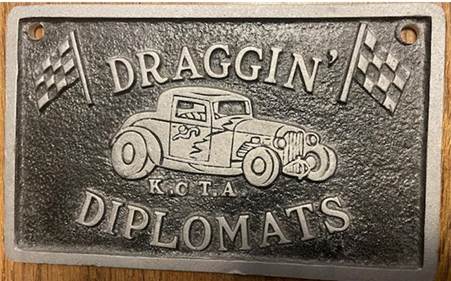
The club had a cool a license plate (above). Bill and I lost ours long ago, but Jim saved his and made it a 60th birthday present to Bill. Below, from the birthday party in 2001, Jim, Bill and Lonnie.
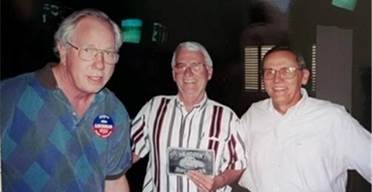
After we graduated in 1959, we spent much of that summer cruising and at the dragstrip. We also took a road trip to Wichita for a big regional drag race event. One of the competitors in the top fuel dragster class was Lou Cangelose from Kansas City. He was driving a Chrysler-powered dragster known as the “Missouri Missile.” Bill and Jim knew him from working the tech line at the KC dragstrip. They had also been to his home to buy a used camshaft for the club’s Chrysler. In 1958, Cangelose was the runner-up in the national A-dragster class, losing to the legendary Don Garlits.
Cangelose’s crew needed a car with the right bumper height to push start the dragster. My car was put into action. A crew member drove my car while we stayed in as passengers. This is the only photo I have of my 1954 Ford.

I don’t remember how Cangelose did that day, but we all heard what happened to him in June of 1965 at the Springfield Ozark Dragway. He crossed the finish line at 198 mph and deployed his parachute to slow the car in the shutdown area. The chute did not open, and Cangelose could not slow the car before it raced through a fence and into some trees. He was killed (age 51).
Mob Trivia: Even as innocent teenagers, we thought Cangelose was connected to the mob. The FBI and KC Police thought so…

Honing his future drag racing skills, “Black Louie” Cangelose was a driver for Tony Gizzo, the boss of the Kansas City crime family from 1950 to 1953 (the years between Charles Binaggio and Nick Civella). Below, Black Louie’s mugshot.
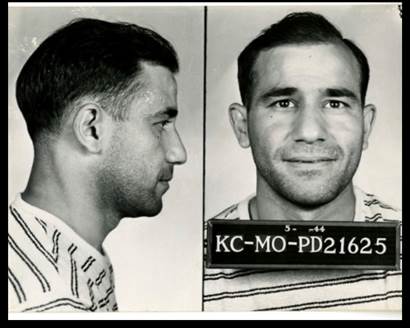
At the end of the summer of 1959, I sold my Ford and went off to college. When I returned the next summer, I bought a 1956 Chevrolet that had been customized, including being lowered and having a beautiful emerald green paint job. The engine was upgraded for high performance (mostly wasted on me – I was a spectator of drag racing, not a participant). The summer of 1960 was much like 1959, but with a cooler car. I don’t have a photo of my 1956 Chevy, but it looked a lot like this red one I saw at an auto show.
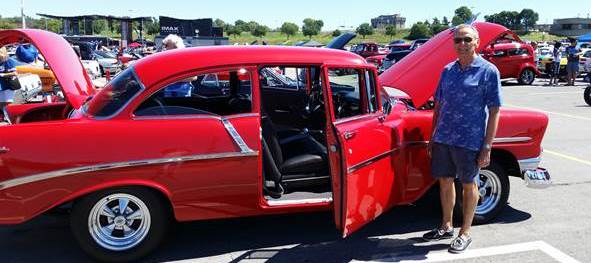
To give Ford equal time, this is a 1956 model Rita and I saw when touring Cuba in 2016.
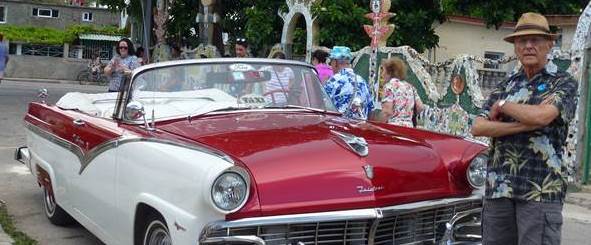
To continue the setlist, a sampling from the 1960s…
“409” by the Beach Boys (1962). “My four-speed dual quad posi-traction 409.” That would be the 409 cubic inch Chevy engine that first came out in 1961.
“Little Deuce Coupe” by the Beach Boys (1963). A song about the beloved 1932 Ford Coupe, a favorite of the hot-rodding and custom car world. It was the yellow car driven by John Milner (Paul Le Mat) in American Graffiti. In the movie, Milner raced against Bob Falfa (Harrison Ford) who drove a black 1955 Chevy (video here).
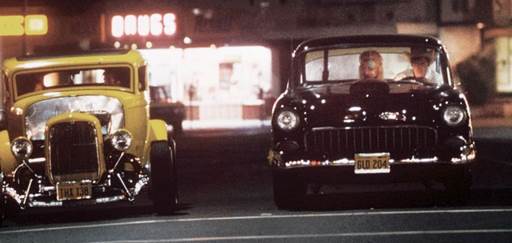
“Shut Down” by the Beach Boys (1963). A fuel-injected Corvette Sting Ray racing a 413 Dodge.
“G.T.O.” by Ronny and the Daytonas (1964). First manufactured in 1963, the Pontiac GTO is credited with popularizing the muscle car segment in the 1960s.
“Little Old Lady from Pasadena” by Jan and Dean (1964). The little old lady has a shiny red super stock Dodge “that she drives real fast and she drives real hard.”
“Mustang Sally” by Wilson Pickett (1967). The singer laments that his girl doesn’t want to do anything but ride around in her new car.
After Jim Graham got out of the Air Force, he thought he deserved a special ride – not like the ones we had to constantly repair when we were teenagers. He went all out. In September of 1966, he bought a “Goodwood Green” 1967 Corvette Sting Ray (the models were released the fall before the designated model year).
When Rita and I visited with Jim recently, he gave us some background on the car. He asked the dealership to hold the car until November 12. That’s the day Jim would turn 25 and the insurance rates would become reasonable. He said he had one surprise that he had not seen in the promotional materials – a raised white scoop in the middle of the hood (see below; not Jim’s car, but one like it). The 1967 model was available with two engine sizes – 327 or 427 cubic inches – and the hood scoop was a feature only for the models with a 427 engine.
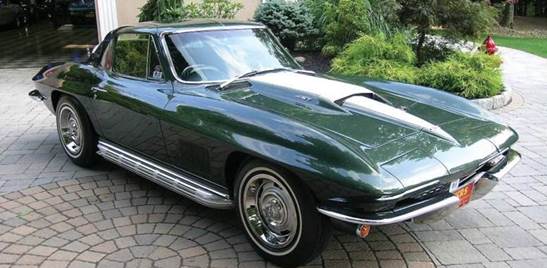
Who else got a Goodwood Green 1967 Corvette Sting Ray in the fall of 1966? President Joe Biden. He married his first wife in August of 1966, and his father-in-law (a Chevrolet dealer) gave the couple the Corvette as a wedding gift. Note that the hood on Biden’s car (below) does not have a scoop, meaning he has the 327 engine. The engine size was confirmed in a Jay Leno video featuring President Biden drag racing against Michael Powell, son of Colin Powell, who was driving his late father’s Corvette (video here).
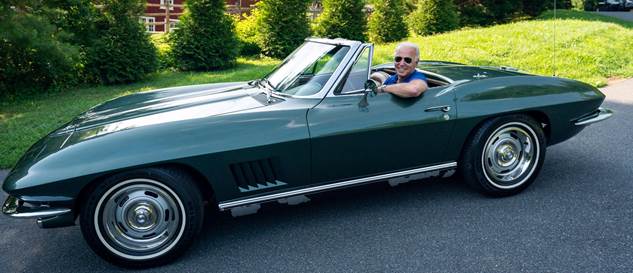
Jim Graham parted with his Corvette decades ago. POTUS still has his.
Spelling Trivia: The Corvettes of 1963 to 1967 were Sting Rays (two words). In 1968, Corvettes became Stingrays (one word).
“Little Red Corvette” by Prince (1983). The song is about a one-night stand with a fast woman who Prince metaphorically calls his “Little Red Corvette” because she quickly moves on to another man.
Little Red Corvette
Baby, you’re much too fast
Little Red Corvette
Need to find a lover that’s gonna last
Sounds like Chuck Berry’s lament in 1955. “Maybellene, why can’t you be true.”
When Prince died at age 57, General Motors ran this tribute ad.
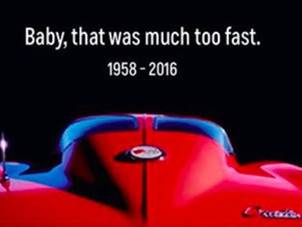
Baseball, rock ‘n’ roll and cars. Thank you 1955.